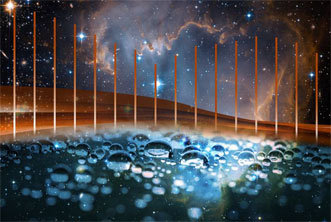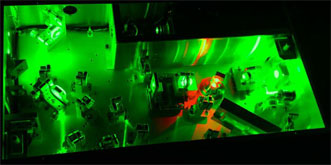A frequency comb that generates and detects terahertz waves throughout a wide spectral range could allow precise measurement of molecules in deep space.
California Institute of Technology (Caltech) chemists combined commercially available lasers and optics with custom-built electronics to extend frequency comb technology into the terahertz (or submillimeter) regime, creating a device with unprecedented spectral coverage and precision.
The device comprises two Ti:sapphire femtosecond laser oscillators and uses the principle of asynchronous optical sampling THz time-domain spectroscopy. The comb's thousands of "teeth" are evenly spaced every 80 MHz across the majority of the terahertz region of the spectrum (0.15 to 2.4 THz), giving the team a way to measure absorption in a sample at all of those frequencies simultaneously.

A new frequency comb operating in the terahertz range could aid the study of organic molecules in space and the soft interactions between molecules in water. Illustration courtesy of Lance Hayashida/Caltech.
"With radio waves, most tuners let you zero in on and listen to just one station, or frequency, at a time," said Geoffrey A. Blake, a professor of chemistry, cosmochemistry and planetary sciences at Caltech. "Here, in our terahertz approach, we can separate and process more than 10,000 frequencies all at once. In the near future, we hope to bump that number up to more than 100,000."
After the device generates its tens of thousands of evenly-spaced frequencies, the waves travel through a sample (e.g., water vapor). The instrument then measures what light passes through the sample and what is absorbed by molecules at each tooth along the comb. If a detected tooth gets shorter, the sample absorbed that particular terahertz wave. If the tooth comes through at its baseline height, the sample did not absorb at that frequency.
"When we look up into space with terahertz light, we basically see this forest of lines related to the tumbling motions of various molecules," said Ian Finneran, graduate student and National Science Foundation fellow who works within Blake’s lab. The task of understanding and unraveling these lines is difficult, “as you must trek across that forest one point and one molecule at a time in the lab ... What we've developed, this terahertz comb, is a way to analyze the entire forest all at once,” Finneran said.


Femtosecond pulses of red light are generated by a Ti:sapphire laser and then converted into terahertz light. The red glowing component is the Ti:sapphire crystal, surrounded by mirrors used in the laser. Courtesy of Brandon Carroll/Caltech.
Everything in the universe that is warmer than about 10 K (-263 °C) gives off terahertz radiation. Even at these very low temperatures, molecules have fingerprints in the terahertz. Astronomers using telescopes such as Caltech's Submillimeter Observatory, the Atacama Large Millimeter Array and the Herschel Space Observatory are searching stellar nurseries and planet-forming disks at terahertz frequencies, searching for such chemical fingerprints to determine the kinds of molecules that are present and thus available to planetary systems. But in just a single chunk of the sky, it would not be unusual to find signatures of 25 or more different molecules. Simply stated, the terahertz region of the spectrum is full of information that currently is inaccessible.
"Since we know exactly where each of the tick marks on our ruler is to about nine digits, we can use this as a diagnostic tool to get these frequencies really, really precisely," Finneran said. "When you look up in space, you want to make sure that you have such very exact measurements from the lab."
In addition to the astrochemical application of identifying molecules in space, the terahertz comb could also be useful for studying fundamental interactions between molecules. "The terahertz is unique in that it is really the only direct way to look not only at vibrations within individual large molecules that are important to life, but also at vibrations between different molecules that govern the behavior of liquids such as water," Blake said.
The findings were published in Physical Review Letters (doi: 10.1103/PhysRevLett.114.163902).
For more information, visit www.caltech.edu.